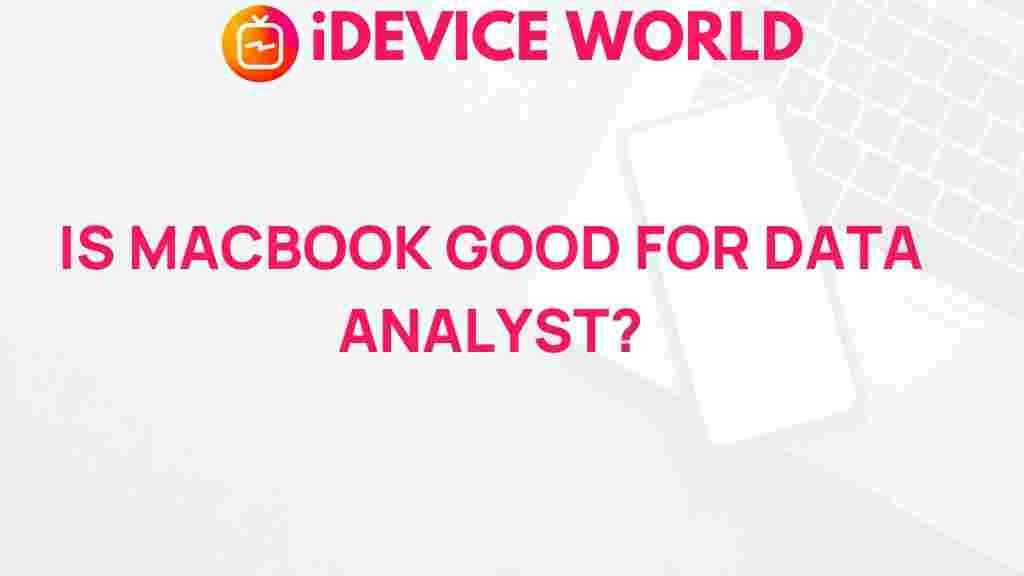Unveiling the Truth: Is MacBook Ideal for Data Analysts?
As technology continues to evolve, the tools that data analysts rely on are becoming increasingly sophisticated. One such tool is the laptop, with the MacBook being a popular choice among professionals. But is the MacBook truly the ideal machine for data analysts? In this article, we’ll explore the features of the MacBook, its pros and cons for data analysis, and help you determine if it’s the right fit for your needs.
Understanding the Needs of Data Analysts
Data analysts require robust hardware and software capabilities to perform their tasks efficiently. Their work often involves:
- Data collection and cleansing
- Statistical analysis
- Data visualization
- Reporting findings
Given these requirements, let’s examine if the MacBook can meet them effectively.
Features of the MacBook
The latest MacBook models, including the MacBook Air and MacBook Pro, come with impressive specifications. Here’s a breakdown of some key features:
- Processor: Options for M1 and M2 chips that provide powerful performance for demanding applications.
- RAM: Configurable up to 24GB, which is essential for multitasking and handling large datasets.
- Storage: SSD options ranging from 256GB to 2TB, allowing for quick data access and ample storage for datasets.
- Display: Retina display offers high resolution, crucial for data visualization tasks.
- Battery Life: Long battery life that supports a full day of work without needing a charge.
Pros of Using a MacBook for Data Analysis
The MacBook offers several advantages for data analysts:
- Performance: With Apple’s M1 and M2 chips, you can expect fast processing speeds, making data manipulation and analysis smoother.
- Software Compatibility: Many data analysis tools such as Python, R, and SQL are available on macOS, allowing for seamless integration.
- User Experience: The macOS interface is intuitive and user-friendly, which can increase productivity.
- Design and Build Quality: The MacBook is known for its sleek design and durability, making it a stylish choice for professionals.
Cons of Using a MacBook for Data Analysis
Despite its advantages, the MacBook is not without drawbacks:
- Price: MacBooks are generally more expensive than their Windows counterparts, which might not be feasible for everyone.
- Limited Customization: Unlike many Windows laptops, MacBooks offer limited options for hardware upgrades.
- Software Limitations: While most data analysis tools are available, some specific applications may be optimized for Windows only.
Step-by-Step Guide to Setting Up Your MacBook for Data Analysis
Setting up your MacBook for data analysis involves a few essential steps:
Step 1: Install Necessary Software
Begin by installing the software you’ll need:
- Python: Use Homebrew to install Python easily. Open your terminal and type:
brew install pythonStep 2: Organize Your Work Environment
Creating an efficient workspace can enhance productivity:
- Use a dual monitor setup if possible.
- Organize files in folders for easy access.
- Consider using productivity tools like Trello or Asana to manage projects.
Step 3: Familiarize Yourself with macOS
Understanding the macOS environment can streamline your workflow:
- Explore shortcuts to improve navigation.
- Use Spotlight Search for quick access to applications and files.
- Customize your Dock for easy access to frequently used applications.
Troubleshooting Common Issues
While using a MacBook for data analysis, you may encounter some issues:
Issue 1: Slow Performance
If your MacBook is running slowly, consider these tips:
- Close unnecessary applications to free up RAM.
- Clear cache files regularly.
- Upgrade your RAM if your model allows it.
Issue 2: Software Compatibility
If you face compatibility issues with certain applications:
- Check for updates for the software.
- Consider using virtualization software like Parallels to run Windows applications.
Issue 3: Battery Drain
If your battery drains quickly:
- Adjust your display brightness.
- Turn off Bluetooth and Wi-Fi when not in use.
- Monitor background applications that consume power.
Conclusion
In conclusion, the MacBook is a strong contender for data analysts, thanks to its powerful performance, excellent display, and user-friendly interface. However, the higher price point and potential software limitations may deter some users. By carefully evaluating your needs and the features of the MacBook, you can make an informed decision. Whether you’re a seasoned analyst or just starting, understanding the strengths and weaknesses of your tools is crucial to your success. For more resources on data analysis tools, check out this comprehensive guide.
This article is in the category Reviews and created by iDeciveWorld Team
